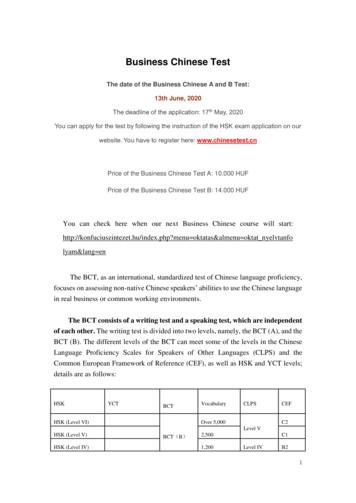Next Level Of Water Re-use - A New Conference
Next Level of Water Re-use« New challenges demanding new solutions »Finn Skov NielsenSales Manager, Industry DKDir: 45 8746 3323Mob: 45 2023 3499E-mail: FIN@kruger.dkDate:
Krüger - VeoliaWater treatment from A to ZWe act as Consultants Contractors SuppliersWe provide Design Processes Technologies Standard Components Service and operation Complete solutions2
Water Re-useWater ScarcityLack of access to clean drinking waterNew challenges call for new solutionsWater Mapping: Reduce, Reuse, Recycle, Reclaim Water resources Water Fit for PurposeWIIXMappingTrue Cost of WaterPRESENTATION TITLE / SUBTITLE / DATEWater resources Tap Water Waste water Cow Water Rain water Others3
Nestlé, Lagos de Moreno, MexicoChallenge Reduce the Water Impact in the local areaCompany goal of reducing waterconsumption per ton of product by 40%,Nestlé’s objective was to create thecompany’s first “zero-water” dairymanufacturing site in the world.Requires 1.6 million liters of water a day the average daily consumption of 6,400people in Mexico.Waste Water TreatmentMBRROUVReuse 800 m3 per dayDischargePRESENTATION TITLE / SUBTITLE / DATE4
Nestlé, Lagos de Moreno, MexicoBenefits Maximising productive uptime Increased production mitigate risk of production disruption due toinsufficient water access Ensure access to sustainable resources Delivering CSR objectives Ensure license to grow thanks to a reliable water feedand decrease dependency on freshwater in a waterstress regionEnhance brand image and reputationPRESENTATION TITLE / SUBTITLE / DATE5
COOPERL, FranceSlaughterhouse with processing and by-product productionChallenge Cooperl water needs: 20 000 m3/week, 4 000 m3/day(5 days)Limited water supplyLimited Discharge to MWWTP
COOPERL, FranceSlaughterhouse with processing and by-product productionBenefits Reuse 10.000 m3/week50% Cooperl water needs
FreislandCampina, Alter BEChallenge Sustainable growth, Water reduction per amount of product (- 20%)Extension production - extra drinking water usage and waste waterEconomic reasons Increase drinking water cost, Increase local taxes (doubled last 10 years) groundwater extraction, Limitation existing pre-treatment, Limitation municipalWWTPLimitation:Waste Water TreatmentDAFMBRCow Water TreatmentROUVReuse 100 m3 per HDischargeReuse 50 m3 per H8
FreislandCampina, Alter BEBenefitsReduced operating costs: Estimated 2M savings per year; Incentives to reduce costsMaximising productive uptime: Supportplant expansion and guaranteed assetuptime to support productionHealth & Safety: Reduced risk relative towater withdrawalEnvironmental footprint: Showcase forsustainability; Water footprint reductionincentivesPRESENTATION TITLE / SUBTITLE / DATE9
Technologies for Water ReusePre-TreatmentMembrane Bio ReactorMore than 50 references fromfood process companies all overthe world including more than 10companies in EuropeReverse OsmosesDisinfectionPRESENTATION TITLE / SUBTITLE / DATE10
Presentation title / Chapter titleThanks for your attentionFinn Skov NielsenSales Manager, Industry DKDir: 45 8746 3323Mob: 45 2023 3499E-mail: FIN@kruger.dk
Water Re-use. PRESENTATION TITLE / SUBTITLE / DATE 3. Water Scarcity. Lack of access to clean drinking water. New challenges call for new solutions Water Mapping: Reduce, Reuse, Recycle, Reclaim Water resources Water Fit for Purpose Water resources Tap Water Waste water Cow Water Rain water Others WIIX Mapping True Cost of Water
stair pressurization fan condensing units, typ. of (3) elevator overrun stair pressurization fan november 2, 2016. nadaaa perkins will ]mit ]] ]site 4 october 21 2016 10 7'-3" hayward level 1 level 2 level 3 level 4 level 5 level 6 level 7 level 1 level 2 level 3 level 4 level 5 level 6 level 7 level 8 level 9 level 10 level 11 level 12
Wishy-Washy Level 2, Pink Level 3, Red Level 3, Red Level 4, Red Level 2, Pink Level 3, Red Level 3, Red Level 4, Red Level 3, Red Level 4, Red Level 4, Red Titles in the Series Level 3, Red Level 3, Red Level 4, Red Level 3, Red Also available as Big Books There Was an Old Woman. You think the old woman swallowed a fly? Kao! This is our
AK-16 of theAnswer Key. Then add the total number of points per grade level. Test Level Test Level Test Level Test Level 101 - 110 Level 1 201 - 210 Level 2 301 - 310 Level 3 401 - 410 Level 4 501 - 510 Level 5 601 - 610 Level 6 701 - 710 Level 7 801 - 810 Level 8 FIRST GRADE TEST ADMINISTR
HSK YCT BCT Vocabulary CLPS CEF HSK (Level VI) BCT(B) Over 5,000 Level V C2 HSK (Level V) 2,500 C1 HSK (Level IV) 1,200 Level IV B2. 2 HSK (Level III) YCT (Level IV) BCT(A) 600 Level III B1 HSK (Level II) YCT (Level III) 300 Level II A2 HSK (Level I) YCT (Level II) 150
needs. For example if the level of water drops below the threshold level in a bore well, the motor pump may get affected due to dry running. There are many other situations where water level monitoring is an important task. 3.WATER LEVEL SENSOR The water level Indicator employs a simple mechanism to detect and indicate the water level in an .
Modified Feed In, Compass Draw, and Single Elimination. Level 1 Level 2 Level 3 Level 4 Level 5 Champion. 3000 1650 900 540 300. 2nd Place. 2400 1238 675 405 225. 3rd Place. . Level 1 Level 2 Level 3 Level 4 Level 5 Level 6 Level 7 Position # 1. 300 180 150 90 45 30 8. Position # 2. 275 156 128 78 39 26 7. Position # 3. 250 131 105 67 33 22 6 .
Grey water-Recycling - In a german household [1] General Grey water-Recycling 48l Grey water-Recycling 70l Grey water 22l Grey water-discharge 25l Black water 25l Black water-discharge 25l toilet flush water 5l irrigation 48l service water from Grey water-Recycling 13l laundry washing 5l cleaning 52l drinking water 40l shower, bathtubs, wash .
ANSI A300 defines as a tree risk assess-ment: “A systematic process used to identify, analyze, and evaluate risk.” “Mitigation” is a term that I see com-monly used inappropriately. In the Standard, it is very clearly defined as the process of diminishing risk. We do not eliminate risk in trees when we perform some form of mitigation practice. We are minimizing the risk to some .























